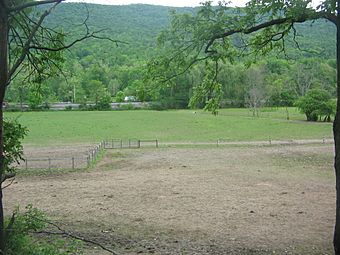Fisher Farm site facts for kids
Quick facts for kids |
|
|
Fisher Farm site
|
|

The site is a farm today
|
|
| Location | Along U.S. Route 220, straddling a rail line |
|---|---|
| Nearest city | Unionville |
| Area | 3.5 acres (1.4 ha) |
| Built | 1200 |
| NRHP reference No. | 82003781 |
| Added to NRHP | March 3, 1982 |
The Fisher Farm site is an exciting archaeological site located in Centre County, Pennsylvania, United States. It's found in fields near the town of Unionville. This site is super important for understanding ancient life in central Pennsylvania.
Contents
What is the Fisher Farm Site?
The Fisher Farm site covers about 3.5 acres (1.4 ha) of land. It sits on the north side of Bald Eagle Creek. Today, most of the site is made up of farm fields.
A railroad line cuts the site into two parts. There's also an old streambed running through the fields. Farmers have been plowing these fields since at least the 1870s. But people were farming here long before European settlers arrived.
Archaeologists believe this site was once a Late Woodland farming village. People lived here between the years 1200 and 1600 AD.
Digging Up the Past: Excavations
Archaeologists started digging at the Fisher Farm site in 1976. These digs continued through 1978. In 1976, they did smaller tests. These tests showed how important the site was.
Because of the early findings, bigger digs happened in 1977 and 1978. During these years, they dug up hundreds of square meters of fields. They also explored the old streambed near Bald Eagle Creek.
In 1977, they found nine burials. They also found 63 other interesting artifacts. The 1978 dig was also very successful. It uncovered pollen and carbon-14 samples. These samples helped scientists figure out the age of the site. They also helped them understand what the area was like long ago. The site was named after its owner, Ivan Fisher.
What We Learned from Fisher Farm
The Fisher Farm site has taught us a lot about the Late Woodland period. This is especially true for central Pennsylvania. Before this site was studied, most research focused on large, stockaded villages. These villages were usually found along big rivers.
The Fisher Farm site was different. It was smaller than the fortified villages. It was also located along a smaller waterway. Sites like this had not been studied much before.
Scientists think these smaller villages might have been connected to the larger communities. But they are still debating if people moved between the big and small villages.
Much of what we know about the culture comes from pottery. This pottery was found in 1978 in the old streambed. Before, people thought pottery styles changed very suddenly. But the pottery at Fisher Farm shows a slower change. It seems designs developed gradually over time.
The Fisher Farm site was also the first of many villages to be dug up in the Nittany Valley. Because of this, it has become a very important type site for the region. The discoveries here have helped create a new understanding of Late Woodland culture.
A Recognized Historic Place
In 1982, the Fisher Farm site was added to the National Register of Historic Places. This means it is recognized as a very important archaeological site in the United States.



